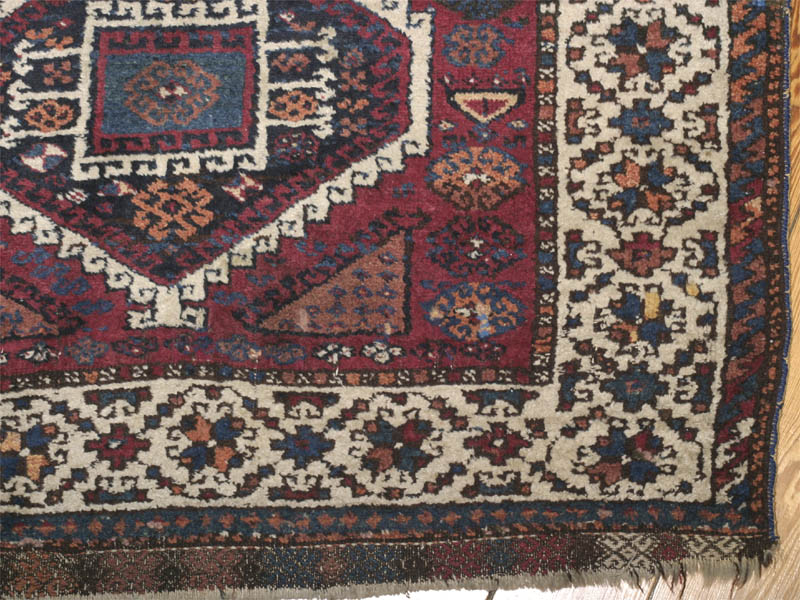This pretty and full pile rug in remarkable condition matches the description given by Eagleton (in his seminal "Introduction to Kurdish rugs") for rugs from Kurds (or possibly by Armenians before the were expelled) in the Gaziantep (ex Aintab) region of Anatolia, due to the characteristic main border. "The small hooks and squares that make up the border design are found nowhere else in Kurdistan" (compare text to plate 117). His plate 116 and 121, also attributed to the Gaziantep region, show both the same row of three connected medallions, each with a central rectangular motif with long horizontally extended hooks.
The size of this rug is 4 x 6.8 feet (122 x 207 cm). The structure is all wool, with beige wool warps (not depressed) and two dark brown wool wefts after each row of knots. Knotting is coarse as usual fo tribal pieces of this provenance: approximately 7 symmetrical knots per inch horizonal and 8 knots vertical (56 kpsi). The sides have a blue-yellow herringbone overcast, the ends, with some loss in the corners, show beautiful weft-float brocading on the dark brown kilim.
The condition is remarkably good for a rug of this age. There is a full fleecy pile everywhere, only slightly lower in the centre than around the edges. I can detect three small areas of repiling with synthetic dyes, each about a square inch in surface; two can be seen in the pictures. They do not pop out very much, but could be easly repiled with yarn that better matches the original colours. Apart from a very faint grey stain on the right border of the central medallion white outline that I spotted only after considerable exploration, I can see no other stains. The rug is clean and has no odour. It has no tears, holes or kinks, and has nowhere been 'cut and shut'. It lies perfectly flat on the floor.
The colors are all saturated and beautiful, they all look natural (apart from 3 very small repairs, see below). The purple red cochineal field (an insect dye) has a beautiful abrash. Cochineal was used a lot instead of madder in eastern Anatolia in the second half of the nineteeth century. Interestingly, blue is absent; instead, we find a range of hues of a beautiful teal (blue-green) that complements the cochineal rather well. The main border has a white background. Eagleton claims for this Gaziantep type that "white borders, which are the most attractive, are the rarest" (text to plate 117). Apart from these three main colours, the cochineal and the teal appear in lighter shades, then there is dark and light apricot, a fine light yellow used sparingly in the filler motifs, and a chestnut brown in the triangular elements ajoining the hexagonal medallions. Outlining is done in dark brown wool, whether from brown sheep or dyed with walnut or similar I cannot tell.







